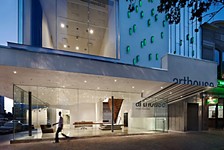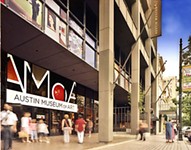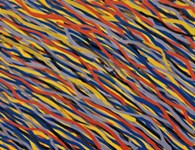Reflections in a Blank Wall
Florian Slotawa's exhibition tells us more about Arthouse than the artist
By Rachel Cook, Fri., Dec. 21, 2007
Sometimes an artist imports his practice into a space to create what is typically referred to as a site-specific installation. He utilizes the actual walls of the exhibition space as elements within the installation, adding or subtracting elements, shifting walls, floors, or even ceilings to create a world filled with his colors, sounds, movements, and textures. Acting much more along the lines of a theatrical designer or art director in a film, the artist brings his installation to life in the exhibition space. Yet sometimes an artist comes into a space by infiltrating it from the inner structure out, not only rearranging objects but also confronting the edifice and logic put into place by the institution itself.
Berlin-based Florian Slotawa gets to the core of the organization Arthouse with his first U.S. solo exhibition, "One After the Other," currently on view in the organization's home at 700 Congress. What might at first seem like a blank show with no tangible work is, in fact, Slotawa's sleight of hand: the artist shifting the architecture of the galleries' walls, cutting an opening in the ceiling, blocking the traditional entrance of the exhibition space. He peels back the layers of the wall to expose the past and then creates a portal through the ceiling into the future – all of which forces the organization to look at itself both structurally and historically. The building where Arthouse is located has a long history on the 700 block of Congress. It has been there since 1851 – predating both the state Capitol, which was completed in 1888, and the University of Texas, on which construction began in 1882. First, the building was home to a drugstore, Tobin's; then, most notably, it housed one of the first movie theatres in Austin, L.L. Hegman's Queen Theater. Then, Lerner Shops, a women's department store, occupied the building for 40 years, until finally in 1995, the Texas Fine Arts Association (Arthouse's former name) purchased the building and turned it into a visual arts space.

From the moment you walk into Arthouse, Slotawa transforms your path, forcing you to travel to the back of the building to enter the exhibition. With this simple shift, he takes you back in time, past a mural on the wall from when Arthouse was the Queen. From there, he takes you through a maze of blank white walls in a bizarre configuration that has no exit except the way you entered; I found this slightly problematic because I wanted to be led out in a different direction. Eventually, you arrive in front of a wooden staircase leading to a small portal through which you may view the second floor of the building. The space is vacant now, but Arthouse is working with the design firm Lewis.Tsurumaki.Lewis to develop the building's upper levels into artists' studios, a 6,000-square-foot gallery, a multipurpose community room, and a rooftop terrace; it's where the future of Arthouse is going. Viewing the vast empty space while standing on the wooden staircase with half of your body in the space above and the other half still in the space below feels similar to entering a tree house that you can't climb all the way into. You are only allowed to imagine what it would feel like to explore and touch the walls filled with remnants of the past history of the building.
So in essence, Slotawa's site-specific installation extends beyond the walls of the exhibition area of Arthouse into the offices, the bathrooms, and rooftop, etc. Driving by, I find myself admiring the building as a whole and evaluating the plot of land that the building at 700 Congress occupies as one giant sculpture. One of Slotawa's most successful installations was in Germany at Bonner Kunstverein, an organization with very little in the way of resources but an enormous exhibition area. Slotawa told me that when he first visited the venue, he was struck by how congested the offices were and how much they had stacked and packed everywhere, so he decided to move the overcrowded administrative offices into the massive gallery space and put his exhibition in their moderate-sized office spaces. Slotawa seems to get himself into situations like this quite frequently; he'll be invited to do a show by an institution that perhaps has an idea or expectation of what he will create, and, almost to spite them, he'll take the equation and spin it on its head. With the exhibition described above, he not only made the organizers move their offices but also told them that while they were in this giant exhibition space, maybe they should throw out and organize some of their stuff. Maybe the artist becomes the best evaluator of the institution.

It is fitting for Arthouse to allow an artist to take over the entire building as a way to evaluate the organization as a whole. In choosing Slotawa for her debut as Arthouse's new curator, Elizabeth Dunbar has not only commissioned a bold new site-specific work; she has also helped create a clean slate in terms of Arthouse's curatorial focus. The organization that Arthouse grew out of was founded in 1911 to promote art activity throughout the state, so its focus then was supporting and promoting Texas art. As the state has changed over the decades, so has the organization's focus. In recent years, Arthouse has broadened its focus to contemporary art outside Texas as well as inside it, as seen through a programming mix of traveling shows, open juried exhibitions, annual fundraisers, and the biennial Arthouse Texas prize exhibition, with a relative handful of exhibitions curated in-house by key staff members, such as Regine Basha, who, during her four-year stint as adjunct curator, was responsible for such shows as "The Gospel of Lead: Dario Robleto and Jeremy Blake" and "Daniel Bozhkov: Recent Works." While the blank walls and lack of intervention will most likely confuse viewers who walk through the space, this may be Dunbar's way of bringing the focus back to the organization itself and where it has been and where it is going. What does it mean "to promote the growth and appreciation of contemporary art" and "to deepen the public's understanding of contemporary art," as Arthouse's mission states? That's the question raised by this exhibition, and only time will tell how the organization will answer it.
"Florian Slotawa: One After the Other" is on view through Jan. 13 at Arthouse, 700 Congress. For more information, call 453-5312 or visit www.arthousetexas.org.












